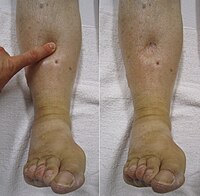
Photo from wikipedia
Intensive care unit (ICU) patients are at high risk for limb edema, which caused complications such as pain, joint contracture, limited range of motion and atrophy of the limbs. Thus,… Click to show full abstract
Intensive care unit (ICU) patients are at high risk for limb edema, which caused complications such as pain, joint contracture, limited range of motion and atrophy of the limbs. Thus, this study was conducted to compare ICU patients' upper limb edema between two groups with the intervention of limb elevation and intermittent pneumatic compression (IPC). In this quasi‐experimental before and after study, 40 patients were recruited. One upper limb was randomly assigned to the upper limb elevation (ULE) group and the other one was assigned to the IPC group. The circumference of the wrist and the middle of the arm were compared between and within groups. Results showed that in both groups of IPC and ULE and all five sessions (unless the second session of ULE), participants' arm and wrist edema were reduced significantly after the interventions (arm: P < .01; wrist: P < .0001). The differences between the two groups of ULE and IPC in regards to limb edema reduction were not significant. Although there was no significant difference between IPC and ULE intervention in the removal of edema, ULE seems to be more feasible and practical, which should be assessed in future studies.
Journal Title: International Wound Journal
Year Published: 2022
Link to full text (if available)
Share on Social Media: Sign Up to like & get
recommendations!